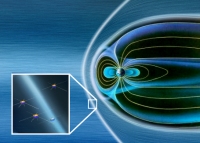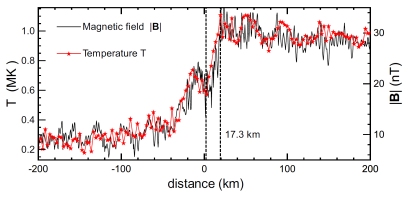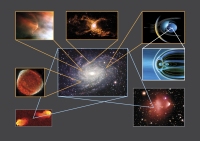Cluster reveals Earth's bow shock is remarkably thin
16 November 2011
A new study based on data from ESA's Cluster mission has revealed that the bow shock formed by the solar wind as it encounters Earth's magnetic field is remarkably thin: it measures only 17 kilometres across. Thin astrophysical shocks such as this are candidate sites for early phases of particle acceleration. The finding thus sheds new light on the much debated issue of particle injection in the context of cosmic ray acceleration. |
| Artist's impression of the four Cluster spacecraft flying through the thin layer of Earth's bow shock. Credit: ESA/AOES Medialab |
These abrupt transitions between supersonic and subsonic flows have been observed in a variety of cosmic environments, most notably in stellar winds gusting from young and massive stars, in the shell-like remnants of supernova explosions and in the proximity of the lobes and jets emanating from radio galaxies. Observations at radio frequencies, as well as in X-rays and gamma rays, have revealed that shocks are also intimately connected to the origin of cosmic rays, the most energetic particles in the Universe.
"A unique opportunity to tackle such questions is represented by Earth's bow shock, the standing shock wave that forms when the solar wind encounters the magnetosphere of our planet," explains Steven Schwartz from Imperial College London, UK. Schwartz led a team that used data from ESA's Cluster mission to obtain pioneering measurements of the thickness of this transition layer. The thickness of the bow shock is a crucial parameter in investigating the physical processes taking place in that region. "It turns out that the bow shock is remarkably thin – only about 17 kilometres across. This means that it may be a far more efficient particle accelerator than we suspected," he adds. These results are reported in a paper to appear in the 18 November 2011 issue of Physical Review Letters.
Unlike shock waves around faraway stars and galaxies, the Earth's bow shock can be studied in situ by spacecraft flying through it. "The bow shock is an extraordinary laboratory to directly probe plasma dynamics and to explore scales that are inaccessible to astronomical observations," comments Matt Taylor, Cluster Project Scientist at ESA. "With four spacecraft flying in formation, Cluster is the only space mission able to disentangle temporal and spatial dependencies in its data, and measure spatial variations in the temperature and other physical properties of particles in the plasma that surrounds our planet," he adds.
In 2003, an analysis based on Cluster measurements set an upper limit to the bow shock's thickness, hinting that it is at most 100 kilometres across. The new study led by Schwartz successfully exploited a particularly favourable set of data to precisely constrain the width of the shock. The results demonstrate that the width is about one-fifth of previous estimates.
"We dug into the massive archive of the Cluster mission to look for events characterised by a slow crossing of the shock by the spacecraft," notes Schwartz. A slow crossing means that the bow shock, which undergoes fluctuations due to changes in the solar wind, is relatively stable as the spacecraft fly through it. This, in turn, means that the scientists can sample the particle population more accurately, with better temporal and, consequently, better spatial resolution.
 |
| The magnetic field and electron temperature in the plasma surrounding Earth's bow shock. Image courtesy of Steven Schwartz, Imperial College London |
"As the spacecraft make the transition into the shocked region of the plasma, they record how the electrons experience a dramatic and abrupt rise in temperature over scales of only about 17 kilometres," continues Schwartz. Such a sharp transition is close to the limit set by wave dispersion and could hardly be any steeper, implying that the shock layer is as thin as it can be. "And thin shocks make better accelerators," Schwartz adds.
In the vicinity of very thin shocks, a particle acceleration mechanism known as multiple reflection, or surfing, becomes particularly efficient. Ions that are initially slow, with energies of only a few keV, are energised gradually by repeatedly 'bouncing off' the shock. The shock initially presents as a discontinuity that the ions cannot cross. After several rebounds, the ions gain enough energy (of the order of 0.5 MeV or beyond) to pass through the shock.
| Particle acceleration via multiple reflections off a thin astrophysical shock. Credit: ESA/AOES Medialab. (For larger versions of this video click here) |
This mechanism may be a solution to the injection problem in cosmic accelerators. If a shock can be this thin, particles 'surfing' along it may be accelerated to a sufficiently high energy threshold that they can then be fed to different mechanisms that accelerate them to very high energies, well beyond 1 GeV, such as those reported in cosmic ray studies.
"These results show how local studies in the Solar System can have a major impact on the understanding of cosmic particle acceleration, an ubiquitous phenomenon which is active on a wide range of scales across the Universe," concludes Taylor.
Notes for editors
The study presented here is based on data gathered by the four Cluster spacecraft on 9 January 2005. On this occasion, the combination of a slowly moving shock and a favourable orientation of the magnetic field, which was aligned with the spacecraft spin axes, enabled data to be sampled with unprecedented time resolution – at intervals of 250 milliseconds, corresponding to one sixteenth of the time interval that a spacecraft needs to complete a full spin. The data show that, in the transition layer between the non-shocked and shocked regions of the plasma, half of the total heating undergone by electrons takes place on a scale of 17.3 kilometres.
Cluster is a constellation of four spacecraft flying in formation around Earth. It is the first space mission able to study, in three dimensions, the natural physical processes occurring within and in the near vicinity of the Earth's magnetosphere. Launched in 2000, it is composed of four identical spacecraft orbiting the Earth in a pyramidal configuration, along a nominal polar orbit of 4 × 19.6 Earth radii (1 Earth radius = 6380 km). Cluster's payload consists of state-of-the-art plasma instrumentation to measure electric and magnetic fields over a wide frequency range, and key physical parameters characterizing electrons and ions from energies of nearly 0 eV to a few MeV. The science operations are coordinated by the Joint Science Operations Centre (JSOC), at the Rutherford Appleton Laboratory, United Kingdom, and implemented by ESA's European Space Operations Centre (ESOC), in Darmstadt, Germany.
Related publications
S. Schwartz, et al., "Electron Temperature Gradient Scale at Collisionless Shocks", 2011, Physical Review Letters, 107, 215002, DOI: 10.1103/PhysRevLett.107.215002
Contacts
Steven J. Schwartz
Space & Atmospheric Physics
The Blackett Laboratory, Imperial College London
London, UK
Email: s.schwartz imperial.ac.uk
imperial.ac.uk
Phone: +44-20-7594-7660
Matt Taylor
Cluster Project Scientist
Directorate of Science and Robotic Exploration
ESA, The Netherlands
Email: Matthew.Taylor esa.int
esa.int
Phone: +31-71-565-8009



